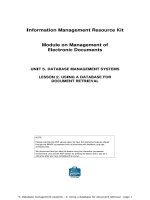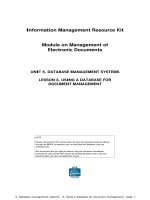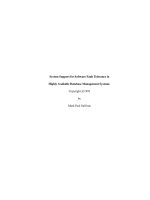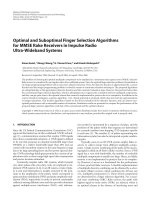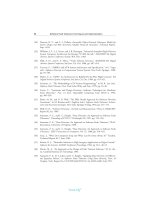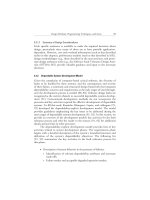System Support for Software Fault Tolerance in Highly Available Database Management Systems
Bạn đang xem bản rút gọn của tài liệu. Xem và tải ngay bản đầy đủ của tài liệu tại đây (811.34 KB, 250 trang )
System Support for Software Fault Tolerance in
Highly Available Database Management Systems
Copyright
c
1992
by
Mark Paul Sullivan
System Support for Software Fault Tolerance in Highly Available
Database Management Systems
by
Mark Paul Sullivan
Abstract
Today, software errors are the leading cause of outages in fault tolerant systems. System
availability can be improved despite software errors by fast error detection and recovery
techniquesthat minimize total downtime after an outage. This dissertationanalyzessoftware
errors in three commercial systems and describes the implementation and evaluation of
several techniques for early error detection and fast recovery in a database management
system (DBMS).
The software error study examines errors reported by customers in three IBM systems
programs: the MVS operating system and the IMS DBMS and DB2 DBMS. The study
classifies errors by the type of coding mistake and the circumstances in the customer’s
environment that caused the error to arise. It observes a higher availability impact from
addressing errors, such as uninitialized pointers, than software errors as a whole. It also
details the frequencies and types of addressing errors and characterizes the damage they do.
The error detection work evaluates the use of hardware write protection both to detect
addressing-related errors quickly and to limit the damage that can occur after a software
error. System calls added to the operating system allow the DBMS to guard (write-protect)
2
some of its internal data structures. Guarding DBMS data provides quick detection of
corrupted pointers and similar software errors. Data structures can be guarded as long as
correct softwareis given a means to temporarilyunprotectthedata structures beforeupdates.
The dissertation analyzes the effects of three different update models on performance,
software complexity, and error protection.
To improve DBMS recovery time, previous work on the POSTGRES DBMS has sug-
gested using a storage system based on no-overwrite techniques instead of write-ahead log
processing. The dissertation describes modifications to the storage system that improve
its performance in environments with high update rates. Analysis shows that, with these
modifications and some non-volatile RAM, the I/O requirements of POSTGRES running a
TP1 benchmark will be the same as those of a conventional system, despite the POSTGRES
force-at-commit buffer management policy. The dissertation also presents an extension to
POSTGRES to support the fast recovery of communication links between the DBMS and
its clients.
Finally, the dissertation adds to the fast recovery capabilities of POSTGRES with two
techniques for maintaining B-tree index consistency without log processing. One technique
is similar to shadow paging, but improves performance by integrating shadow meta-data
with index meta-data. The other technique uses a two-phase page reorganization scheme
to reduce the space overhead caused by shadow paging. Measurements of a prototype
implementation and estimates of the effect of the algorithms on large trees show that they
will have limited impact on data manager performance.
i
ii
Acknowledgements
go here
iii
Contents
List of Figures vi
List of Tables viii
1 Introduction 1
1.1 Software Failures and Data Availability
1
1.2 A Model of Software Errors Incorporating Error Propagation
5
1.3 Existing Approaches to Software Fault Tolerance
8
1.4 Organization of This Dissertation
11
2 A Survey of Software Errors in Systems Programs 15
2.1 Introduction
15
2.2 Previous Work
18
2.3 Gathering Software Error Data
20
2.3.1 Sampling from RETAIN
24
2.3.2 Characterizing Software Defects
25
2.4 Results
31
2.4.1 Error Type Distributions
32
2.4.2 Comparing Products by Impact
48
2.4.3 Error Triggering Events
50
2.4.4 Failure Symptoms
57
2.5 Summary
61
3 Using Write-Protected Data Structures in POSTGRES 64
3.1 Introduction
64
3.1.1 System Assumptions
66
3.2 Models for Updating Protected Data
69
3.2.1 Overview of Page Guarding Strategies
69
3.2.2 The Expose Page Update Model
73
3.2.3 The Deferred Write Update Model
76
CONTENTS
iv
3.2.4 The Expose Segment Update Model
84
3.3 Performance Impact of Guarded Data Structures
87
3.3.1 Performance of Guarding in a DBMS
88
3.3.2 Performance of Guarding in a DBMS
90
3.3.3 Reducing Guarding Costs Through Architectural Support
95
3.4 Reliability Impact of Guarded Data Structures
98
3.5 Previous Work Related to Guarded Data Structures
100
3.6 Summary
103
4 Fast Recovery in the POSTGRES DBMS 106
4.1 Introduction
106
4.2 A No-Overwrite Storage System
111
4.2.1 Saving Versions Using Tuple Differences
113
4.2.2 Garbage Collection and Archiving
116
4.2.3 Recovering the Database After Failures
124
4.2.4 Validating Tuples During Historical Queries
134
4.3 Performance Impact of Force-at-Commit Policy
135
4.3.1 Benchmark
136
4.3.2 Conventional Disk Subsystem
142
4.3.3 Group Commit
144
4.3.4 Non-Volatile RAM
145
4.3.5 RAID Disk Subsystems
147
4.3.6 RAID and the Log-Structured File System
149
4.3.7 Summary
152
4.4 Guarding the Disk Cache
153
4.5 Recovering Session Context
156
4.5.1 Communication Architecture of POSTGRES
157
4.5.2 Recovery Mechanism for POSTGRES Sessions
159
4.5.3 Restarting Transactions Lost During Failure
162
4.6 Summary
165
5 Supporting Indices in the POSTGRES Storage System 168
5.1 Introduction
168
5.2 Assumptions
173
5.3 Support for POSTGRES Indices
175
5.3.1 Traditional B-tree Data Structure
176
5.3.2 Sync Tokens and Synchronous Writes
177
5.3.3 Technique One: Shadow Page Indices
178
5.3.4 Technique Two: Page Reorganization Indices
186
5.3.5 Delete, Merge, and Rebalance Operations
192
5.3.6 Secondary Paths to Leaf Pages: B
link
-tree 195
5.3.7 Dynamic Hashing for POSTGRES
199
CONTENTS
v
5.4 Concurrency Control
200
5.5 Using Shadow Indices in Logical Logging
204
5.6 Performance Measurements
209
5.6.1 Modelling The Effect of Increased Tree Heights
210
5.6.2 Measurements of the POSTGRES B
link
-tree Implementation 213
5.6.3 Estimating Additional I/O Costs During Recovery
216
5.7 Summary
218
6 Conclusions 220
6.1 Future Work
224
6.1.1 Providing Availability for Long-Running Queries
224
6.1.2 Fast Recovery in a Main Memory Database Manager
225
6.1.3 Automatic Code and Error Check Generation
226
6.1.4 High Level Languages
227
Bibliography 229
vi
List of Figures
1.1 Causes of Outages in Tandem Systems 3
2.1 DB2 Error Type Distribution
33
2.2 IMS Error Type Distribution
33
2.3 MVS Regular Sample Error Type Distribution
34
2.4 Control/Addressing/Data Error Breakdown DB2, IMS, and MVS Systems 35
2.5 Summary of Addressing Error Percentages in Previous Work
37
2.6 Distribution of the Most Common Control Errors
40
2.7 Distribution of the Most Common Addressing Errors
43
2.8 MVS Overlay Sample Error Type Distribution
44
2.9 DB2 Error Trigger Distribution
51
2.10 IMS Error Trigger Distribution
51
2.11 MVS Error Trigger Distribution
52
2.12 Error Type Distribution for Error-Handling-Triggered in DB2
56
2.13 Error Type Distribution for Error-Handling-Triggered in IMS
56
2.14 MVS Overlay Sample Failure Symptoms
58
2.15 MVS Regular Sample Failure Symptoms
59
2.16 IMS Failure Symptoms
59
2.17 DB2 Failure Symptoms
60
3.1 POSTGRES Process Architecture
67
3.2 Example of Extensible DBMS Query
72
3.3 Expose Page Update Model
75
3.4 Deferred Write Update Model
78
3.5 Remapping to Avoid Copies in Deferred Write
83
3.6 Costs of Updating Protected Records
91
4.1 Forward Difference Chain
114
4.2 Backward Difference Chain
114
4.3 Creating an Overflow Page
121
LIST OF FIGURES
vii
4.4 Tuple Qualification
130
4.5 Phases of the Client/Server Communication Protocol
159
5.1 Conventional B-tree Page
176
5.2 Shadowing Page Strategy
179
5.3 Shadowing Page Split
180
5.4 Two Page Splits During the Same Transaction
180
5.5 Page Split For Page Reorganization B-trees
188
5.6 A merge operation on a balanced shadow B-tree
193
5.7 Normal B
link
-Tree 195
5.8 Worst-Case Inconsistent B
link
-Tree 196
5.9 Height of Tree for Different Size B-trees
212
viii
List of Tables
2.1 Average Size of an Overlay 47
2.2 Distance From Intended Write Address
48
2.3 Operating System and DBMS Error Impacts
50
3.1 Raw Costs of Guarding System Calls
89
3.2 Performance Impact of Guarding a CPU-Bound Version of POSTGRES
93
3.3 Performance Impact of Guarding an IO-Bound Version of POSTGRES
93
4.1 Summary of I/O Traffic in a Conventional Disk Subsystem
143
4.2 Group Commit in a Conventional Disk Subsystem
145
4.3 Summary of I/O traffic When NVRAM is Available
148
4.4 Comparison of Random I/Os in RAID and a Conventional Disk Subsystem 149
4.5 Comparison of I/Os in LFS RAID and a non-LFS Conventional Disk Sub-
system
151
5.1 Insert/Lookup Performance Comparison
214
1
Chapter 1
Introduction
1.1 Software Failures and Data Availability
Commercial computer users expect their systems to be both highly reliable and highly
available. Given a system’s service specification, the system is reliable if does not deviate
from the specification when it performs its services. The system is available if it is prepared
to perform the services when legitimate users requests them. A fault tolerant system is one
that is designed to provide high availability and reliability in spite of failures in hardware
or software components of the system. Once a fault tolerant system is in production, it
maintains high reliability through error detection, halting an operation rather than providing
an incorrect result. Fault tolerant systems achieve high availability by recovering transient
state quickly after an error is detected, minimizingdowntime to increase overall availability.
Traditionally, fault tolerant systems have focused on detecting and masking hardware
CHAPTER 1. INTRODUCTION
2
(material) faults through hardware redundancy [42]. In today’s fault tolerant systems,
however, software failures, rather than hardware failures, are the largest cause of system
outage [30]. Figure 1.1 compares outage distributions in three years of a five year study
of Tandem Corporation’s highly available systems. In the figure, outages are classified by
the nature of the failure that caused the outage. Software outages are caused by failures
of the operating system, database management system, or application software. Hardware
outages arecaused by double failuresof hardwarecomponents,including microcode. Errors
made by the people who manage and maintain the system are separated into operator
and maintenance errors, since the system’s owners controlled day-to-day operations while
Tandem wasresponsiblefor routine maintenance. Environmentfailures include fires,floods,
and power outages of greater than one hour.
Tandem’s studies found that outages shifted over time from a fairly even mix across all
sources to a distribution dominatedby software failures. From 1985 to 1989, software went
from causing 33% of outages to 62%. By 1989, the second and third largest contributors,
operations and hardware, were at fault only 15% and 7% of the time, respectively.
For Tandem, the trend is not due to worsening software quality, but to success in
curtailingoutagescausedbyhardware and maintenance failures. Overall,Tandem’s systems
have gradually become more reliable; the mean time between system failureshas risen from
8 years to 21 years. The reliability of the hardware components from which the systems are
built has increased. Hardware redundancy techniques have gone a long way in detecting
and masking faults when those hardware components do wear out. The increasingly
CHAPTER 1. INTRODUCTION
3
1989
1987
Failures
50
40
30
20
10
0
Percent of
60
1985
70
Hardware Maint.
Environ.OperatorSoftware
Figure 1.1: Causes of Outages in Tandem Systems. The chart represents the
results of three years of a five year study. Outages are classified by the nature
of the component that failed. The graph shows a dramatic shift to software
as the primary cause of system outage. The bars for a given year do not sum
to 100% because the causes of some outages could not be identified.
CHAPTER 1. INTRODUCTION
4
reliable hardware also needs less maintenance. When maintenance is required, many of the
maintenance tasks have been automated in order to limit the errors that the maintenance
engineers can make. The rate of operator errors has remained constant, but it should soon
improve for some of the same reasons that maintenance error rates improved. Operator
interfaces are becoming less complex, hence, operators are less likely to make mistakes.
Over time, more of the tasks currently done by operators will be automated as well, which
removes the opportunity for operator errors. Thus, while progress in these areas has had
a noticeable impact, the growing dominance of software outages is making continued
advances in non-software fault tolerance less and less important.
A second study from Tandem indicates another software-related limit to system fault
tolerance [29]. Even when software does not cause the original outage, it often determines
the duration of the outage. Once an outage of any sort occurs, the system must reestablish
software state lost at the time of the failure. While the system is reinitializing, it is
unavailable to its users. A thorough approach to improving system availability must also
address software restart time.
This dissertation focuses on part of the software fault tolerance problem: improving the
reliability and availability of the database management system (DBMS). The integrity and
availabilityof data managedby aDBMS is usually an importantfeatureof the environments
in which fault tolerant systems are used. In Tandem’s outage study, the DBMS accounted
for about a third of the software failures (the remainder being divided between operating
system, communication software, and other applications). While we focus on the DBMS,
CHAPTER 1. INTRODUCTION
5
much of the work is applicable to other systems programs.
Before presenting the approach to software fault tolerance taken in the dissertation, this
chapter introduces a model of errors and describes some existing software fault tolerance
techniques. The model and some of the terms defined in the first section below will be
used throughout the dissertation. A review of the software fault tolerance literature is in the
section following the description of the error model. The final section below outlines the
remainder of the dissertation.
1.2 A Model of Software Errors Incorporating Error Prop-
agation
The software error model used in this dissertation highlights one of the significant
differences between hardware and software failure modes, error propagation.Using
redundancy, hardware components can detect their own errors and often recover without
disturbing the system. Software errors, on the other hand, sometimes cause damage that
is not detected immediately. The damaged system can initiate a sequence of additional
software errors as it executes, eventually causing the system to corrupt permanent data or
fail. Error propagation complicates software failure modes, making the code difficult to
reason about, test, and debug. Reproducing propagation-related failures during debugging
is difficult since error propagation can be timing dependent.
To explore software fault tolerance techniques in the DBMS, we propose a model that
CHAPTER 1. INTRODUCTION
6
distinguishes between software errors based on the waysin whichthey propagate damage to
other parts of thesystem. Themodel breaks softwareerrorsintothreeclasses: controlerrors,
addressing errors, and data errors. Control errors include programmer mistakes such as
deadlock in which the point of control (the program counter) is lost or the program makes
an illegal state transition. The only corruption that occurs is to the variables representing
the current state of the program. Control errors can propagate only when the broken module
communicates with other parts of the system. Addressing errors corrupt values that the
faulty routine did not intend to operate on. An uninitialized pointer would be an addressing
error, for example. Propagation from addressing errors is the most difficult to control since,
from the standpoint of the module whose data has been corrupted, the error is “random”;
it happens at a time when the module designers do not expect to communicate with the
faulty module. Data errors corrupt the values computed by the faulty routine. A data
error causes the program to miscalculate or misreport a result. Like control errors, data
errors can propagate only to modules related to the routine with the error. Unlike many
addressing errors, the source of the corruption in a data or control error can be tracked
during debugging by examining the code that is known to use the corrupted data.
In future database management systems, the impact of the cross-module error propaga-
tion caused by addressing errors may increase because of two trends in DBMS design: data
manager extensibility and main memory resident databases. Extensible DBMSs include
extended relational systems [70], object-oriented systems [6], and DBMS toolkits [14]. An
extensible DBMS lets users or database administrators add access methods, operators, and
CHAPTER 1. INTRODUCTION
7
data types to manage complex objects. Moving functionality from DBMS clients to the
DBMS itself improves application performance but could worsen system failure behavior.
Extensibility allows different object managers with varying degrees of trustworthiness to
run together in the data manager. Every time one user on the system tries to use a new
object manager or combine existing ones in a different way, there is a risk of uncovering
latent errors. Because of addressing errors, this risk is not confined to the person using the
new feature; it affects the reliability and availability achieved by all concurrent users of the
database.
System designers have realized for some time that DBMS performance would improve
dramatically if the database resided entirely in main memory instead of residing primarily
on disk (e.g. [20]). Years ago, main memory capacity was the factor limiting the appeal of
main memory DBMSs. In high-end systems today, however, main memories large enough
to hold many databases are available, and memory prices are dropping. Commercial
systems still do not use main memory DBMSs, probably because system designers believe
that data stored main memory is more likely to be corrupted by errors than data stored
on disk. Corruption due to hardware and power failures can be eliminated if existing
redundancy techniques based onthose discussed in [42] are applied to largemain memories.
Operator and maintenance errors could harm data on disk as easily as data in memory. This
leaves software errors as the largest remaining reliability difference between disk-resident
databasesmemory-residentones. Ina main memory DBMS,the danger of error propagation
makes addressing errors one of the most important differences in the risk to data in main
CHAPTER 1. INTRODUCTION
8
memory and on disk.
1.3 Existing Approaches to Software Fault Tolerance
Current strategies for reducing the impact of software errors on systems fall into two
classes: fault preventionandfault tolerance. System designers would obviously prefer not to
havesoftwareerrorsatallthantoinventtechniquesfortoleratingthem. Somesoftwareerrors
are prevented through modular design, exhaustive testing, and formal software verification.
A survey of error prevention techniques is presented in [57]. Although most software
designs incorporate one or more of these techniques, the complexity and size of concurrent
systems programs such as the operating system and database management system make
error prevention alone insufficient for achieving high system reliability and availability.
Since fault prevention alone is not effective, software fault tolerance techniques are
used to detect and mask errors when they occur in the system. Like hardware fault
tolerance, software fault tolerance is usually based on redundancy. Because software errors
are usually design errors, rather than material failures, redundancy-based techniques have
limited effectiveness in software. Redundant hardware components can be expected to
fail independently, but software design errors often do not cause failure independently in
each redundant components. Most redundant software schemes only mask software errors
triggered by hardware transients and unusual events, such as interrupts, that might arrive at
the redundant components at different times.
CHAPTER 1. INTRODUCTION
9
Systems that tolerate software faults usually employ either spatial redundancy, tem-
poral redundancy, or a hybrid of the two. Spatial redundancy uses concurrent instances
of the program running on separate processors in the hope that an error that strikes in one
instance will not occur in any of the others. In temporal redundancy, the system tries to
clean up any system state damaged by the error and retry the failed operation. Wulf [81]
makes the distinction between spatial and temporal redundancy in a paper on reliability in
the Hydra system.
N-version programming [3] is a famous spatial redundancy technique designed as a
software analog of the triple modular redundancy (TMR) techniques commonly used for
hardware fault tolerance. In N-Version programming, there are several versions of a
program each of which is designed and implemented by a different team of programmers.
The N versions run simultaneously, comparing results and voting to resolve conflicts. In
theory, the independent programs will fail independently. In practice, multiple version
failures are caused by errors in common tools, errors in program specification, errors in
the voting mechanism, and commonalities introduced during bug fixes [78]. Furthermore,
experimental work [43][67] has indicated that even independent programmers often make
the same mistakes. Not surprisingly, different programmers find the same tasks difficult
to code correctly. For example, different programmers often forget to check for the same
boundary conditions.
Most database management systems rely on temporal redundancy to recover from
software errors. Most of recovery techniques surveyed in Haerder and Reuter [34] restore
CHAPTER 1. INTRODUCTION
10
the database to a transaction-consistent state in the hopes that the error does not occur. The
database management system’s clients then reinitiate any work aborted as a result of the
failure. In [62], Randell describes a temporal redundancy method called recovery blocks.
At the end of a block of code, an acceptance test is run. If the test fails, the operation is
retried using an “alternate” routine. Ideally, this is a reimplementation of the routine that is
simpler, but perhaps less efficient, than the original routine. Recovery blocks require fewer
hardware resources than N-version programs, but may be ineffective for the same reasons
as N-version programs.
Process pairing [7] is a hybrid between spatial and temporal redundancy in which
an identical version of the program runs as a backup to the primary one. The primary
and backup run as separate processes on different processors. In addition to masking
unrepeatable software errors, process pairs reduce the availability impact of hardware
errors since the primary and backup run on different processors. If a hardware error causes
the processor running the primary process to fail, the backup process will take over the
clients of the primary. Because only one team of programmers is required, a process
pair is considerably cheaper than an N-version program. Auragen [13] used a similar
scheme. Another spatial/temporal redundancy hybrid method uses redundant data in the
same address space to reconstruct data structures damaged by errors [76]. When an error is
detected duringan operation on the data structure, the structureis rebuiltusingthe redundant
data and the operation is retried.
A system can only tolerate software errors if these errors are detected in the first
CHAPTER 1. INTRODUCTION
11
place. The most common approach to error detection in systems programs is to lace the
program withadditional code thatchecks forerrors. Sometimes these include data structure
consistency checkers that pass over program data and examine it for internal consistency.
By detecting errors quickly, even systems without redundant components limit the chance
that minor errors will propagate into worse ones.
Unfortunately, checking for errors is expensive. No published figures are available
regarding the cost of error checking in the DBMS, but run time checks for array bounds
overruns in Fortran programs can double program execution time [32]. Furthermore,
the checkers themselves can have software errors. Error checking is not usually done
systematically. The checking code has to be maintained as the software it checks is
maintained. Implementing and testing error checkers increases development cost.
1.4 Organization of This Dissertation
The dissertation makes three contributions towards the goal of improving software fault
tolerance in database management systems. First, it assembles and analyzes a body of
information about software errors that will be useful to software availability and reliability
researchers. Second, it describes the implementation and evaluation of a mechanism for
detecting addressing errors that can be used in conjunction with existing ad-hoc consistency
checkers. Finally, it extends theDBMS fast recovery techniquesof the POSTGRES storage
system [69] in order to improve availability.
CHAPTER 1. INTRODUCTION
12
Chapter Two examines error data collected after software failures at IBM customer
sites in order to improve system designers’ understandings of the ways in which software
causes outage. The chapter presents the results of two software error studies in the MVS
operating system and the IMS and DB2 database management systems and compares these
results to those of earlier software error studies. Chapter Two shows that 40-55% of the
errors reported in these three systems were control errors, while addressing and data errors
were 25-30% and 10-15%, respectively (others could not be classified according to the
model). In addition to the control/addressing/data error breakdown, Chapter Two provides
finer grain classes that include more detail about exactly how the programmer made the
error. The MVS study gives some specific information about the error propagation caused
by addressing errors. For example, these errors are more likely than other software errors
to have high impact on the availability experienced by customers. Addressing errors in
MVS tend to be small and often corrupt data very near the data structure that the software
intended to operateon. This andother datapresented in Chapter Two can be used to provide
a larger picture of software failures in high-end commercial systems that, we hope, will be
useful to others studying fault tolerance and software testing outside of the context of the
dissertation.
Chapter Three focuses on the use of hardwarewrite protectionboth to detect addressing-
related errors quickly and to limit the damage that can occur after a software error. System
calls added to the Sprite operating system allow the DBMS to guard (write-protect) some
of its internal data structures. Guarding DBMS data provides quick detection of corrupted
CHAPTER 1. INTRODUCTION
13
pointers and array bounds overruns, a common source of software error propagation. Data
structures can be guarded as long as correct software is given a means to temporarily
unprotect the data structures before updates. The dissertation analyzes the effects of
three different update models on performance, software complexity, and error protection.
Measurements of a DBMS that uses guarding to protect its buffer pool show two to eleven
percent performance degradation in a debit/credit benchmark run against a main-memory
database. Guarding has a two to three percent impact on a conventional disk database, and
read-only data structures can be guarded without any affect on DBMS performance.
To lessen theavailability impact of errors once they are detected, the DBMS must restart
quickly after such errors are detected. Chapter Four develops an approach to fast recovery
centered on the POSTGRES storage system [69]. The original POSTGRES storage system
was designed to restore consistency of the disk database quickly, but did not consider
fast restoration of non-disk state such as network connections to clients. Chapter Four
describes extensions to POSTGRES required for fast reconnection of the DBMS and its
client processes. The chapter also describes a set of optimizations that reduce the impact
of the storage system on everyday performance, making fast recovery more practical for
databases with high transaction rates. Finally, Chapter Four presents an analysis of the I/O
impact of the POSTGRES storage system on a TP2 debit/credit workload. This analysis
shows that the optimized storage system does the same amount of I/O as a conventional
DBMS when a sufficient amount of non-volatile RAM is available.
Chapter Five also widens the applicability of the POSTGRES fast recovery techniques
CHAPTER 1. INTRODUCTION
14
by extending the POSTGRES storage system to handle index data structures. While the
POSTGRES storage system recovery strategies are effective for restoring the consistency
of heap (unkeyed) relation without log processing, different strategies must be taken for
maintaining the consistency of more complex disk data structures such as indices. The
two algorithms described in Chapter Five allow POSTGRES to recover B-tree, R-tree,
and hash indices without a write-ahead log. One algorithm is similar to shadow paging,
but improves performance by integrating shadow meta-data with index meta-data. The
other algorithm uses a two-phase page reorganization scheme to reduce the space overhead
caused by shadow paging. Although designed for the POSTGRES storage system, these
algorithms would also be useful in a conventional storage system as support for logical
logging. Using these techniques, POSTGRES B-tree lookup operations are slower than a
conventional system’s by 3-5% under most workloads. In a few cases, POSTGRES lookups
also require an extra disk I/O. On the other hand, the system can begin running transactions
immediately on recovery without first restoring the consistency of the database.
The sixth chapter concludes and describes some avenues for future research. Because
the dissertation has four very distinct sections, the literature review for each chapter will be
included in the chapter. Together, these chapters attack three problems of interest to fault
tolerant system designers: they describe the character of software errors, improve error
detection, and widen the applicability of some existing fast recovery techniques.
